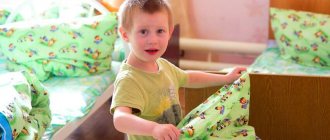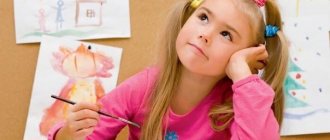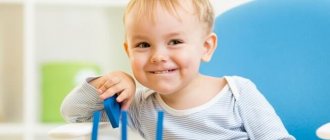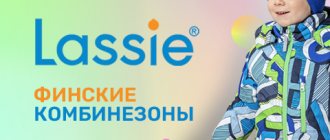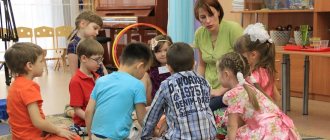Formation of aesthetic feelings in preschool age
Aesthetic education is not innate. It begins to form in early childhood in a social environment. Active and competent pedagogical leadership is critical to the development of aesthetic sensitivity. In the process of aesthetic development, children gradually master the basics of aesthetic culture, aesthetic perception, ideas, concepts, interests, judgments, needs, feelings, creativity and artistic activity. The dynamics of the formation of aesthetic sensitivity and the formation of aesthetic culture involves the passage of several stages directly related to the developmental characteristics of a child at a certain age.
It is advisable to consider the features of early childhood development as a propaedeutic period towards aesthetic acceptance of the surrounding world. This stage begins with the formation of sensory sensitivity and subsequent emotional “reaction” to acquaintance with the most striking qualities and characteristics of objects that surround the child. From early childhood he pays attention to everything beautiful, bright, colorful and shiny. Aesthetic perception of the environment has its own specific characteristics. For a child, the most important thing is the sensory form of things, namely their shape, color, sound, smell. Therefore, the aesthetic education of a child requires a certain level of development of sensory culture.
The child perceives beauty as the unity of content and form. Form is the unity of lines, sounds, colors. But an aesthetic child can perceive only when the perception is emotionally charged, because aesthetic appreciation is closely related to feelings and emotions. Aesthetic feelings are distinguished by the fact that they are accompanied by an encounter with the beautiful light of spiritual excitement and selfless joy. Thus, we can conclude that an important component in the formation of aesthetic feelings is the emotional reaction to the perceived object. But the full formation of aesthetic feelings cannot occur with an abstract, “passive” perception of reality.
Activities in preschool age are also important for the formation and development of aesthetic feelings. At an early age, techniques for imitation of various types of primitive games and artistic activities are formed, and a feeling of satisfaction develops not so much from performing the activity, but from the achieved result.
The development of language contributes to the assimilation of the names of a much larger number of reference signs, aesthetic qualities through comparison: dirty - clean, small - big, sad - cheerful, ugly - beautiful, etc.
It is necessary to pay attention to the fact that in most cases preschoolers cannot separate the concepts of “correct” and “beautiful”, which has great potential for the implementation of both moral and aesthetic educational tasks. In preschool age, aesthetic education of children is carried out by parents “intuitively” rather than purposefully. But at the same time, aesthetic education in the family plays an important role in the aesthetic development of a preschool child and the formation of his personality, despite the fact that parents do not have pedagogical and methodological skills. In the family, family traditions are the basis of aesthetic education, ensuring continuity between generations, the formation of aesthetic values, role models and experience. Therefore, it is also important to carry out explanatory and methodological work with parents of preschool children on aesthetic education.
In the conditions of a preschool educational institution, subsequent changes occur in the aesthetic development of the child. The child becomes more receptive to certain elements of art form, such as color, rhythm and rhyme. Children also begin to react differently to the work itself. Their motivation to evaluate a work of art is secular or subjective. Young children usually notice individual features of a phenomenon, express their thoughts briefly and sometimes use very specific assessments.
Aesthetic education of children of senior preschool age
MINISTRY OF EDUCATION OF THE REPUBLIC OF BELARUS
COURSE WORK IN PEDAGOGY
"AESTHETIC EDUCATION OF SENIOR PRESCHOOL AGE"
TABLE OF CONTENTS
INTRODUCTION . . . . . . . . . . . . . . . . . . . . . . . . . . . .. . . . . . . . . . . . . . . . . . 4
CHAPTER 1. THEORETICAL FOUNDATIONS OF AESTHETIC EDUCATION OF PRESCHOOL CHILDREN……………………………………………………6
1.1. The essence of aesthetic education. . . . . . . . . . . . . . . . .. . . . . . . . . . . . …6
1.2. Psychological and pedagogical features of preschool age. . . .. . . 10
1.3. The role of nature in aesthetic education. . . . . . . . . . . . . . .. . . . . . . . . . 12
CHAPTER 2. WAYS TO IMPROVE WORK ON THE AESTHETIC EDUCATION OF CHILDREN USING NATURE…………………………………………………………….16
2.1. Determination of the level of aesthetic development of children of senior preschool age. . . . . . . . . . . . . . . . . . . . . . . . .. . . . . . . . . . . . . . . . . . . . ……………….16
2.2. Methodology for improving the work on aesthetic education of preschoolers using the means of nature. . . . . . . . . . . . . . . . . . . .. . . . . . . . . . . . . . .18
CONCLUSION . . . . . . . . . . . . . . . . . . . . . . . . . . . .. . . . . . . . . . . . . . .24
LIST OF REFERENCES….………………25
APPENDIX…………………………………………………….26
INTRODUCTION
Deep aesthetic feelings, the ability to perceive beauty in the surrounding reality and in art are an important condition in the spiritual life of a person. Aesthetics, as is known, is the science of beauty, and aesthetic education is an introduction to beauty in all its manifestations. Even the ancient Greeks believed that beauty, measure, harmony are not only standards of natural phenomena or works of art, but also principles of social life. Aesthetic education is easier and simpler to carry out when everything around a person is beautiful: the streets along which he rushes on business, the houses in which he lives, etc. We place special hopes on aesthetic education as a targeted system of measures designed to awaken in the soul of every person a craving for beauty, admiration for the beautiful in all its manifestations, which will not allow him to do evil, since evil is ugly. It is necessary to start introducing a person to art as early as possible - from preschool age, and to educate him not only as a contemplator and listener, but also as an active creator of beauty. The modern way of life, labor and social relations of people, and the surrounding nature create the prerequisites for the aesthetic development of a child. From early childhood, a child discovers and explores the world around him, he is drawn to the beautiful, bright and experiences the joy of communicating with nature. He discovers the world in a variety of colors and sounds. V.A. Sukhomlinsky wrote “The world surrounding a child is, first of all, the world of nature with an endless wealth of phenomena, with inexhaustible beauty.”
The topic of my research is “Aesthetic education of preschool children.” The relevance of the chosen topic is determined by the fact that in order to effectively carry out work on the aesthetic education of preschoolers using the means of nature, it is necessary to develop a set of classes aimed at educating, clarifying the feelings of a little person, and developing the ability to distinguish shades of color and sound.
The purpose of the study is to determine the most effective ways and methods of aesthetic education of children of senior preschool age using nature.
The object of the study is the aesthetic education of preschool children.
The subject of the study is the forms of work on the aesthetic education of preschoolers using nature.
Research objectives:
- To study the psychological and pedagogical foundations of aesthetic education of older preschoolers.
- Reveal the importance of nature in the aesthetic education of preschool children.
- To identify the main ways and methods of aesthetic education of children of senior preschool age using natural resources.
It can be assumed that if you develop a set of classes aimed at improving the aesthetic education of preschoolers using nature, you can get the following results:
- increase the level of aesthetic development of older preschoolers;
- increase the effectiveness of educators’ work in developing children’s cognitive interest in the beauty of the world around them;
- obtain high rates in the development of the preschooler’s personality as a whole.
Research methods:
- study of psychological, pedagogical and methodological literature on the research problem;
- monitoring the activities of preschool children;
- experimental work aimed at aesthetic education of preschool children using the means of nature.
Research base: preschool institution No. 251 in Minsk.
CHAPTER 1. THEORETICAL FOUNDATIONS OF AESTHETIC EDUCATION
1.1. The essence of aesthetic education
Adults and children constantly encounter aesthetic phenomena. In the sphere of spiritual life, everyday work, communication with art and nature, in everyday life, in interpersonal communication - everywhere the beautiful and the ugly, the tragic and the comic play a significant role. Beauty brings pleasure and pleasure, stimulates work activity, and makes meeting people pleasant. The ugly is repulsive. The tragic teaches empathy. Comic helps to fight shortcomings. The ideas of aesthetic education originated in ancient times. Ideas about the essence of aesthetic education, its tasks, and goals have changed since the times of Plato and Aristotle right up to the present day. These changes in views were due to the development of aesthetics as a science and understanding of the essence of its subject. The term “aesthetics” comes from the Greek “aisteticos” (perceived by the senses). Materialist philosophers (D. Diderot, N.G. Chernyshevsky) believed that the object of aesthetics as a science is the beautiful. This category formed the basis of the aesthetic education system. In our time, the problem of aesthetic education, personality development, and the formation of its aesthetic culture is one of the most important tasks facing the school. This problem has been developed quite fully in the works of domestic and foreign teachers and psychologists. Among them D.N. Jola, D.B. Kabalevsky, N.I. Kiyashchenko, B.T. Likhachev, A.S. Makarenko, B.M. Nemensky, V.A. Sukhomlinsky, M.D. Taboridze, V.N. Shatskaya, A.B. Shcherbo and others. In the literature used, there are many different approaches to the definitions of concepts, the choice of ways and means of aesthetic education. Let's look at some of them. V.N. Shatskaya in her book “General Issues of Aesthetic Education at School” writes: “Soviet pedagogy defines aesthetic education as cultivating the ability to purposefully perceive, feel and correctly understand and evaluate beauty in the surrounding reality - in nature, in public life, work, in artistic phenomena” [ 16. c. 6]. In a brief dictionary on aesthetics, aesthetic education is defined as “a system of activities aimed at developing and improving a person’s ability to perceive, correctly understand, appreciate and create the beautiful and sublime in life and art” [11 p. 451]. In both definitions, we are talking about the fact that aesthetic education should develop and improve in a person the ability to perceive beauty in art and in life, to correctly understand and evaluate it. D.B. Likhachev in his book “The Theory of Aesthetic Education of Schoolchildren” relies on the definition given by K. Marx: “Aesthetic education is a purposeful process of forming a creatively active personality of a child, capable of perceiving and appreciating the beautiful, tragic, comic, ugly in life and art, living and creating.” according to the laws of beauty" [13 p. 51]. The author emphasizes the leading role of targeted pedagogical influence in the aesthetic development of a child. For example, the development of a child’s aesthetic attitude towards reality and art, as well as the development of his intellect, is possible as an uncontrolled, spontaneous and spontaneous process. Communicating with the aesthetic phenomena of life and art, the child, one way or another, develops aesthetically. But at the same time, the child is not aware of the aesthetic essence of objects, and development is often determined by the desire for entertainment; moreover, without outside intervention, the child may develop incorrect ideas about life, values, and ideals. B.T. Likhachev, as well as many other teachers and psychologists, believes that only targeted pedagogical aesthetic and educational influence, involving children in a variety of artistic and creative activities, can develop their sensory sphere, provide a deep understanding of aesthetic phenomena, raise them to an understanding of true art, the beauty of reality and beauty in the human personality [13 p.42]. There are many definitions of the concept of “aesthetic education”, but having considered only a few of them, it is already possible to identify the main provisions that speak about its essence.
- Firstly, this is a process of targeted influence.
- Secondly, it is the formation of the ability to perceive and see beauty in art and life, and appreciate it.
- Thirdly, the development of the ability for independent creativity and creation of beauty.
Aesthetic education affects both artistic creativity and the aesthetics of everyday life, behavior, work, and relationships. Aesthetic education shapes a person with all aesthetically significant objects and phenomena, including art as its most powerful means. The main thing is to educate and develop such qualities, such abilities that will allow the individual not only to achieve success in any activity, but also to be the creator of aesthetic values, to enjoy them and the beauty of the surrounding reality. In addition to the formation of children’s aesthetic attitude to reality and art, aesthetic education simultaneously contributes to their comprehensive development. Aesthetic education contributes to the formation of a person’s morality, expands his knowledge of the world, society and nature. A variety of creative activities for children contribute to the development of their thinking and imagination, will, perseverance, organization, and discipline. Rukavitsyn M.M., believes: “The ultimate goal of aesthetic education is a harmonious personality, a comprehensively developed person: educated, progressive, highly moral, with the ability to work, the desire to create, who understands the beauty of life and the beauty of art” [21.p. 142]. This goal also reflects the peculiarity of aesthetic education as part of the entire pedagogical process.
The importance of aesthetic education lies in the fact that it makes a person nobler, forms positive moral feelings, and beautifies life. In preschool education, children are introduced to beauty, but we must understand that a child cannot fully understand where the truth of beauty is and where it is fake. Adults need to know the features of aesthetic education: - when talking about beauty, the teacher focuses on feelings, and not on content. — the teacher connects the aesthetic sense with sensory development, because the beauty of all objects is in the unity of shape, color, size, line and sounds. Therefore, it is necessary to organize didactic games for the sensory education of children - the child is imitative, so the teacher should give only positive role models.
Objectives of aesthetic education according to the Praleska program [25]:
- To instill in children a desire to know the world of beauty. To cultivate artistic taste, i.e. to please not only what is bright and catchy, but to be able to give an assessment and express one’s opinion.
- Develop aesthetic behavior.
- Develop artistic creativity in children: be able to sing, sculpt, read poetry, etc.
The main aesthetic category is the category of beauty. It expresses not only an aesthetic, but also a moral assessment. Knowledge about beauty is formed from early childhood through everyday objects that surround children, toys, and works of art. Gradually, by older preschool age, children master the concept of beauty and its application to the phenomena of nature, life, in assessing the activities of people and their actions. Children begin to understand which actions are assessed as beautiful and which as ugly. They will learn that a working person is beautiful, but a lazy person is ugly. Children are taught knowledge about various types of art from early childhood. Decorative toys, pictures, music, books enter a child’s life very early. Children develop knowledge about various expressive means of art (in sculpture, for example, material, pose, gesture, movement, etc.). During preschool age, knowledge about music is also formed: vocal and instrumental, the variety of its themes, genre, structure of individual works, means of musical expression, and various musical instruments. Children get acquainted with folk songs and dances, round dances, works of classical and modern music. The content of aesthetic education also includes the formation in children of elementary knowledge about fiction: Belarusian and foreign. Children acquire knowledge about poetry, stories, folklore: sayings, riddles, epics, and learn to understand the expressive means of literary works (realistic, fairy-tale, lyrical, heroic, humorous, etc.). Children of senior preschool age get acquainted with the names of famous writers, artists, composers, and illustrators of children's books. In the field of musical activity, children master the skills of a culture of listening to music, as well as simple performing skills: singing, musical-motor skills, skills of playing children's musical instruments. In visual activities, children acquire the skills of observing phenomena and objects in the surrounding world. Children also learn to look at works of fine art and analyze their content and means of expression (composition, color, etc.), and distinguish between genres. Aesthetic education can be defined as a purposeful, organized and controlled pedagogical process of formation in an individual of an aesthetic attitude to reality and aesthetic activity. In modern conditions, the following tasks of aesthetic education are put forward in kindergarten:
- Systematically develop the perception of beauty, aesthetic feelings, and ideas of children. All types of art, nature and everyday life contribute to this, causing immediate emotional responsiveness, joy, excitement, admiration, passion.
- To form the foundations of children’s aesthetic taste and the ability to independently evaluate works of art and life phenomena.
- Develop children's artistic and creative abilities.
The main task of aesthetic education is to form a creative attitude towards reality. Work on aesthetic education in a preschool institution is closely connected with all aspects of the educational process, its forms of organization are very diverse, and the results are manifested in various types of activities. This work involves nurturing an aesthetic attitude towards the surrounding reality through familiarization with social and natural phenomena in everyday life, in the process of work, and play; aesthetic education through the means of art. Nature is one of the important factors in the aesthetic development of a person. The most important condition for full-fledged aesthetic education is the environment that surrounds the child in kindergarten: the kindergarten building, the area with its equipment and green spaces, the object environment: furniture, toys. With their appearance, harmony of lines and shapes, color, and variety of content, they contribute to the formation of aesthetic perception and aesthetic feelings. The methodology of aesthetic education is based on the joint activity of the teacher and the child to develop his creative abilities for the perception of artistic values, for productive activity, and a conscious attitude towards the social, natural, and objective environment.
1.2. Psychological and pedagogical features of preschool age
In preschool age, a child increasingly learns about the world outside his family. The content of communication with other people becomes more complex, and the number of activities that the child masters increases. The main tendency of preschool age is expressed in the child’s desire to be the same as an adult. By imitating adults, the child demonstrates independence and learns to do socially useful work. The need to be like an adult is satisfied in role-playing games, the most complex type of activity that a child masters during preschool age. Therefore, when a child, when asked by his parents to do something, replies that he has not finished playing yet, you need to look at what exactly the child is playing. In games, children play out the roles and situations that they see in real life.
In preschool childhood, gaming methodological techniques are widely used. A child learns a variety of activities more successfully if the teacher creates play situations, if artistic material is presented in an exciting way, if play competitions arise between children. The most important significance of the game is that it is a form of organizing the lives of children in which certain relationships develop between them and their feelings, including aesthetic ones, are formed. Simple games in nature bring a lot of joy to children and at the same time develop their powers of observation, imagination, imagination, and sharpen their perception of beauty. Children’s creative abilities are manifested during manual labor, which give children in-depth knowledge about the quality and capabilities of various materials, and help consolidate positive emotions, stimulate the desire to work.
Objectives of aesthetic education of preschool children
Full and harmonious physical and intellectual development, a hierarchy of values, a moral assessment of reality and an active life position determine a comprehensively developed personality, the moral component of which depends primarily on aesthetic education. The kindergarten teacher must help children move from the perception of beauty and emotional reaction to objects of aesthetic feelings to understanding, to the formation of aesthetic concepts, opinions, ideas, assessments, to the formation of a scale of value relations. Aesthetic education is the painstaking work of the educator, which should be carried out unobtrusively and systematically in order to teach children to aesthetically perceive the world around them, experience it, change it, teach them to create a common system of aesthetic norms and experiences, which should become the basis of an aesthetic culture necessary for the harmonious development of the personality of a preschooler. , like all other personal qualities.
The goal of aesthetic education is to develop in children the ability to see the beauty of the life around them and create and transform it. Based on the goal, the tasks of aesthetic education can be divided into two groups.
The development of aesthetic perception, artistic and aesthetic skills, and activity is based on the development of sensory systems at the required time, the work of various analyzers capable of providing the necessary accuracy and subtlety of discrimination.
When performing aesthetic education tasks, children develop such personal qualities as initiative, anticipation of results, desire for them, and the ability to dream. Therefore, the first group of tasks is aimed at developing the aesthetic attitude of preschoolers to the surrounding reality. This group includes tasks that contribute to the development of aesthetic consciousness and perception of preschool children. The following tasks can be distinguished:
- Formation and development of sensory perception;
- Developing the ability to see, understand and feel the aesthetic beauty of nature, human actions and art.
- Familiarization with the system of reference qualities and personality traits, with the gradual inclusion of these names in the active dictionary of preschoolers;
- Give preschool children knowledge about beauty;
- The formation of aesthetic knowledge and judgments, ideas and concepts, which in turn determine aesthetic tastes and assessments, needs and interests;
- Formation and development of aesthetic emotions and feelings in preschool children: The ability to react emotionally to the beautiful and ugly, funny and sad, etc.
- Development of artistic taste, desire and need to study beauty.
Certain tasks require their solution using appropriate tools and methods. As A.S. believed Makarenko, methods are a means of influencing a person, ways by which a targeted pedagogical influence on the consciousness and behavior of students occurs. To complete the tasks of the first group, it is advisable to use methods such as observation, demonstration, example of an adult, and analysis.
The method of exposure is actually found in the first meeting and acquaintance with the subject of aesthetic reality. The teacher must think through the object of the demonstration and organize the lesson so that the children's attention is focused on what they see or hear. When implementing this group of methods, the teacher must be able to express his feeling, his attitude, he must be able to express his feelings in different ways, for example, expressiveness when reading a poetic work, sincere admiration for a beautiful thing or sincere disappointment from carelessness in clothing. The ability of an adult to clearly express his feelings and emotions is an active method of influencing a preschooler, since it is based on imitation of childhood.
Principles of aesthetic education
Aesthetic education of preschool children is carried out in accordance with the principles of modern pedagogy. Accordingly, aesthetic education, its forms, methods and means must correspond to the main goal - the education of a comprehensively developed, active, socially interested person, possessing not only the rudiments of aesthetic judgment and feeling, but also a high degree of aesthetic culture.
It is convenient to emphasize the basic principles underlying modern concepts of aesthetic education.
1) The principle of continuity
First of all, this is the principle of continuity of cultural components of aesthetic education of preschool children. This principle presupposes an inextricable connection between folk aesthetic culture, modern art and the best traditions of the past with the basic principles of aesthetic education.
2) The scientific principle
The scientific principle in aesthetic education should be based on a clear vision, analysis of what has been achieved, predictable results and a direct connection with goals that are significant to society. This principle implies the acquisition by the younger generation of strictly scientific knowledge in accordance with the characteristics of modern art and the stage of its development.
3) The principle of systematicity and programming
The principle under consideration assumes consistency and uniformity in the acquisition of knowledge, skills and aesthetic education in accordance with the age level of development and the use of content, forms and methods of teaching.
4) Principle of complexity
The principle of complexity of aesthetic education should be associated with the harmonious, holistic development of personality, which should be carried out in two directions. First, aesthetic development influences the formation of a child's personality and the development of certain aspects of personality, qualities and abilities. Secondly, the very formation of the personality of a preschool child has a significant impact on his system of values, views, norms and ideas, which at the same time have aesthetic properties.
5) Principle of unity
The principle of the unity of learning and development of the creative potential of preschool children assumes a close relationship between learning and the formation of independent artistic creativity in children. These processes are not considered separately, since creativity is formed in the process of acquiring knowledge, skills and abilities in education, and education brings great results when creative abilities are considered.
The interaction of the creative and educational components varies depending on the educational task: the less mastered the subject, the simpler the creative element; The better a subject is mastered, the wider the field of its combination with creative tasks.
The main way of aesthetic development of a preschool child is the development of his creativity and independent artistic activity. All the principles considered are closely related to each other and determine the direction and planning of the pedagogical process.
List of used literature
BIBLIOGRAPHY
1. Ageeva G.B. Project activity in preschool education // Educatio. – 2015. – No. 7 (14)-1. – pp. 59–60.
2. Arsenina E. N. Musical classes according to the program “From birth to school” (2 junior, middle, senior, preparatory groups).
- Volgograd: Teacher, 2013.
3. Balashova, Yu.S. Formation of artistic creativity and manual skills in children of senior preschool age in the conditions of additional education: abstract of thesis. dis. ...cand. ped. Sci. -M., 2013. - 25 p.
4. Bocharova, N.B. Interaction between family and kindergarten in the formation of cognitive interests in children of senior preschool age using Russian folk arts and crafts: abstract of thesis. dis. ...cand. ped. Sci. - M., 2014. - 27 p.
5. Butenko N.V. Polyartistic approach to the artistic and aesthetic development of preschool children // Bulletin of ChSPU. 2012. No. 8. P.29-39.
6. Butenko N.V., Nikitina E.Yu. Pedagogical principles of artistic and aesthetic development of children during childhood, reflecting the ideas of preschool education // MNKO. 2013. No. 2 (39).
P.15-19.
7. Veraksa, N. E., Komarova, T. S., Vasilyeva, M. A. From birth to school. Sample general education program for preschool education (pilot version).
– M.: Mzaika-Sintez, 2014. – 368 p.
8. Garanina, N.K. The role of the family in introducing preschool children to folk culture // Management of a preschool educational institution: a scientific and practical journal. - 2014. - No. 8. - P. 110-115.
9. Gorina L. V. Designing the content of the educational field “Artistic and aesthetic development” in accordance with the federal state educational standard of preschool education // Modern science: theoretical and applied aspects of development / ch. ed. I. V. Romanova. - Cheboksary: INet, 2014. - Issue. 1. - pp. 61-64.
10. Gorina Lyubov Vyacheslavovna, Kolesnichenko Yulia Yuryevna Artistic and aesthetic development of preschool children // Bulletin of BSU. 2015. No. 1. P.105-109.
11. Denisova, O. P. Psychology and pedagogy [Electronic resource]: textbook. allowance / O. P. Denisova. — 3rd ed., erased. - M.: FLINTA, 2013. - 240 p.
12. Dyachenko, L.Yu. Formation of the foundations of ethnoculture among older preschoolers in musical and folklore activities: abstract. dis. ...cand. ped. Sci. - M., 2014. - 24 p.
13. Zhukova, G.E. Formation of musical and creative abilities of preschool children in cultural and leisure activities: abstract of thesis. dis. ...cand. ped. Sci. - M., 2014. - 23 p.
14. E. Babunova, S. Bagautdinova, S. Obukhova. Features of the social, communicative and artistic and aesthetic development of preschool children in the program and methodological complex “Our Home - Southern Urals”\\ Preschool education. - 2015. - No. 12. - P. 66-68.
15. Zolotukhina A. A., Satvaldyeva O. A., Litvinova O. V. Project activity in the education of preschool children (subject area “Artistic and aesthetic development”) // Young scientist. — 2016. — No. 5.6. — P. 44-46.
16. Zyabkina, V.V. Moral and aesthetic education of preschool children in the process of familiarization with fiction: author's abstract. dis. ...cand. ped. Sci. - Kursk, 2012. - 23 p.
17. Komarova, T. S. Children's artistic creativity. – M.: Mozaika-Sintez, 2010. – 315 p.
18. Komarova, T. S. School of aesthetic education. – M.: Mozaika-Sintez, 2011. – 347 p.
19. Komarova, T. S., Savenkov, A. I. Collective creativity of preschool children. – M.: Prospekt, 2010. – 233.
20. Komarova, T. S., Phillips, O. Yu. Aesthetic developmental environment. – M.: Academy, 2010. – 231 p.
21. Konkevich S. V. Musical instruments. - St. Petersburg: Childhood - Press, 2011.
22. Kudryavtsev V. T. About the developing potential of visual activity. - M.: Tsvetnoy Mir, 2008. - No. 2. - P. 3-4.
23. Kulikova, O.L. Formation of communication skills in children aged 5-7 years in musical and play activities: abstract of thesis. dis. ...cand. ped. Sci. - Yaroslavl, 2013. - 22 p.
24. Kurchavaya T. E. The use of non-traditional techniques in drawing. - St. Petersburg, 2013.
25. Kutsakova L. V. We create and craft. For classes with children 4-7 years old. Manual labor in kindergarten and at home. - M.: Mozaika - Synthesis, 2010.
26. Lesovskaya S. A. Heroes of fairy tales made of plasticine. - M.: Eksimo, 2014.
27. Lesovskaya S. A. Animals made of plasticine. - M.: Eksimo, 2014.
28. Litvinova O. V. Artistic development of preschoolers and primary schoolchildren in the subject-spatial environment of the city [Text]
/ O. V. Litvinova // Development of modern education: theory, methodology and practice: materials of the VI International. scientific-practical conf. (Cheboksary,
1. Nov. 2015) / editorial board: O. N. Shirokov [et al.].
– Cheboksary: CNS “Interactive Plus”, 2015. – No. 4 (6).
– pp. 498–499.
29. Lykova I. A. Design of the educational field “Artistic and aesthetic development”. New approaches in the context of the introduction of the Federal State Educational Standard for Education. - M.: Tsvetnoy Mir, 2014.
30. Lykova, I.A. Aesthetic communication: targets, objectives, content, repertoire // Management of a preschool educational institution: scientific and practical journal. - 2014. - No. 8. - P. 34-42.
31. Makeeva, T. Psychological tests: diagnostics of the development of preschool children [Text]
/ T. Makeeva. – M.: Phoenix, 2010. – 125 p.
32. Mezhetskaya, O.V. Teaching students of children's art schools artistic movement in musical and rhythmic classes: author's abstract. dis. ...cand. ped. Sci. - Ekaterinburg, 2013. - 21 p.
33. Mikhailova, M.V. Development of artistic and imaginative thinking of children 6-7 years old by means of musical and dramatic activities: author's abstract. dis. ...cand. ped. Sci. - M., 2010. - 23 p.
34. Nogina, O.A. Musical and intonation development of young children: author's abstract. dis. ...cand. pedagogical sciences - Chelyabinsk, 2012. - 24 p.
35. From birth to school. Approximate general educational program for preschool education / Ed. N. E. Veraksy, T. S. Komarova, M. A. Vasilyeva. - M.: MOSAIKA-SYNTHESIS, 2014. - 334 p.
36. Federal state educational standard for preschool education / Order of the Ministry of Education and Science of Russia dated October 17, 2013 No. 1155 [Electronic resource].
- URL: https://www.firo.ru/wp-content/uploads/2013/11/PR_1155.pdf (access date: 03/22/2015).
37. Khalikova E. A., Koleboshina N. V. Formation of experience of spiritual and moral behavior of children 4-7 years old: program, planning, classes and matinees of the Orthodox calendar. - Volgograd: Teacher, 2013.
38. Kharchevnikova A.N. Independent role-playing game for four to five years old: features of organization // Kindergarten: theory and practice. – 2012. – No. 10. – P. 48–55.
39. Chichkanova T. A. Development of visual creativity in children of senior preschool age [Text]
/ T. A. Chichkanova // Preschool education: experience, problems, development prospects: materials of the VII International. scientific-practical conf. (Cheboksary,
3. Dec. 2015) / editorial board: O. N. Shirokov [et al.].
– Cheboksary: CNS “Interactive Plus”, 2015. – No. 4 (7).
– P. 59–61.
40. Churashov A.G. Participatory approach to the artistic and aesthetic development of children of senior preschool age through the means of choreography // MNKO. 2013. No. 3 (40).
P.33-35.
41. Churashov A.G. Pedagogical model of artistic and aesthetic development of preschool children by means of choreography // Bulletin of ChSPU. 2012. No. 8. P.184-195.
42. Shaidurova N.V. Folk crafts: card index of subject pictures. - St. Petersburg: Childhood - Press, 2011.


